| Prairie Trees, hmmm, you're probably wondering "what were they thinking?"
***Note, click on an image to see a larger version***
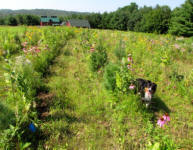
Here's what we're thinking: Since we don't spray for weed/grass control, and do relatively little mowing, our tree plantations are typically pretty wild-looking, and we accept that the seedlings will have to compete with a full range of other plants. Why not, we figure, make those companion plants a prairie mix, and maximize the beauty and habitat values of the entire area? This isn't an entirely new idea for us,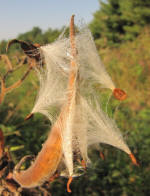 as we've scratched in various prairie wildflowers through much of the plantation over the years. But we've never actually planted a full prairie and set of tree seedlings together, and we aren't aware of anywhere else it has been tried in the Midwest or beyond. as we've scratched in various prairie wildflowers through much of the plantation over the years. But we've never actually planted a full prairie and set of tree seedlings together, and we aren't aware of anywhere else it has been tried in the Midwest or beyond.
So in 2005 we added a new acre to the Christmas trees. First we seeded in a mixture of over 30 species of native mid-grass prairie wildflowers and grasses, then we planted a thousand or so tree seedlings. Where the deer ate the seedlings or they died from competition, we re-planted. 2009 was the first time we did any mowing at all, so we could shear the growing trees and do some thistle control.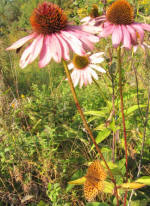 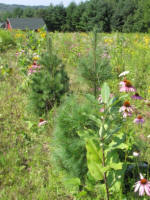
We now have a tremendous diversity of native plants, pollinators, birds, and other wildlife, plus 8 species of Christmas trees coming along at their own sweet time. Can you see the spruce in the background of this coneflower/butterfly foto to the left?
This prairie-tree mixture mimics somewhat the native ecological structure of this area, which during presettlement times was in large part savannah - a mixture of oak and prairie. Conifers weren't naturally a part of that system of course, and we won't be able to burn the area, but we are nevertheless happy with how our "Christmas Prairie" and our "Prairie Trees" have turned out. And maybe we'll just have to make the next step the addition of some scattered white and burr oak trees ... then wait a hundred years and see what happens!
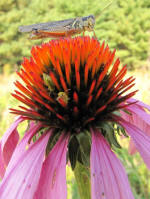 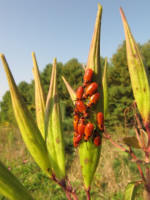 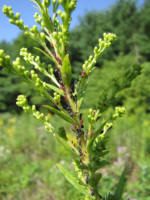
|

